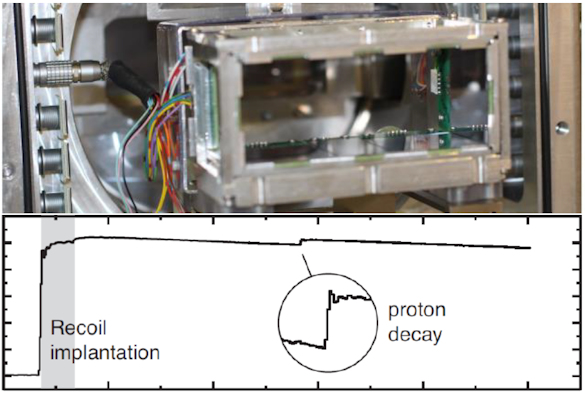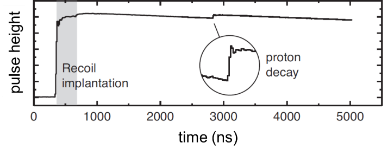Nanosecond-scale proton emission from pumpkin-shaped Lu-149

A light isotope of lutetium, synthesised for the first time, has been found to be the most oblate-deformed proton emitter. The results have been published in Physical Review Letters and chosen as a Research Highlight in Nature. This proton decay is an example of an exotic form of nuclear radioactivity which occurs when the nucleus has a large excess of protons – or, in other words, too few neutrons. For the element Lutetium, with 71 protons, the stable isotope is 175Lu, so the new isotope 149Lu is lacking 26 neutrons and resides at the very limit of nuclear binding. The half-life extracted for the proton decay represents the shortest directly measured value for a proton emitter to date.
The study of particle radiation is one of the fundamental cornerstones of nuclear physics. The direct emission of a proton from a nucleus is a rare but important process that provides important insights into properties at the proton-rich limit of the nuclear landscape. It is highly sensitive to the decay energy, the angular momentum carried by the proton and the nuclear shape.
The 149Lu nuclei were formed by fusing 58Ni and 96Ru nuclei and separated using the MARA vacuum-mode recoil separator at Jyväskylä, Finland, and implanted into a silicon detector. The figure shows the tell-tale signs of a 149Lu proton decay in the digitised output from the detector. There is a big rise in the signal when the 149Lu ion is implanted, followed by a smaller step when the proton is emitted. The proton energy is deduced from the average step height, while the half-life is calculated from the distribution of times the steps occur after ion implantation.

One example of a wave form recorded for the fast proton decay of 149Lu. The grey region marks a dead time set in software.
The measured decay energy of 1910 keV is the highest measured for a ground-state proton decay, and it naturally leads to the shortest directly measured half-life of 450 ns for a ground-state proton emitter. The decay rate is consistent with emission from an ℓ = 5 state, suggesting a dominant πh11/2 component for the wave function of the proton-emitting state. These results can be reproduced by nonadiabatic quasiparticle calculations if the nucleus is strongly oblate deformed. In fact, the quadrupole deformation is the most strongly oblate value (less than −0.17) assigned to a ground-state proton emitter thus far.
Prof. Robert Page, who played a leading role in the interpretation of the data, said “This is a remarkable discovery. Observing proton emission from such a strongly deformed oblate nucleus is unique and opens up exciting possibilities for measuring even shorter-lived proton emitters in the future.” This is the latest of a string of discoveries made by the Liverpool team working with their long-term international collaborators in Jyväskylä.
Further information:
K. Auranen et al., “Nanosecond-Scale Proton Emission from Strongly Oblate-Deformed
149Lu“, Phys. Rev. Lett. 128, 112501 (2022).